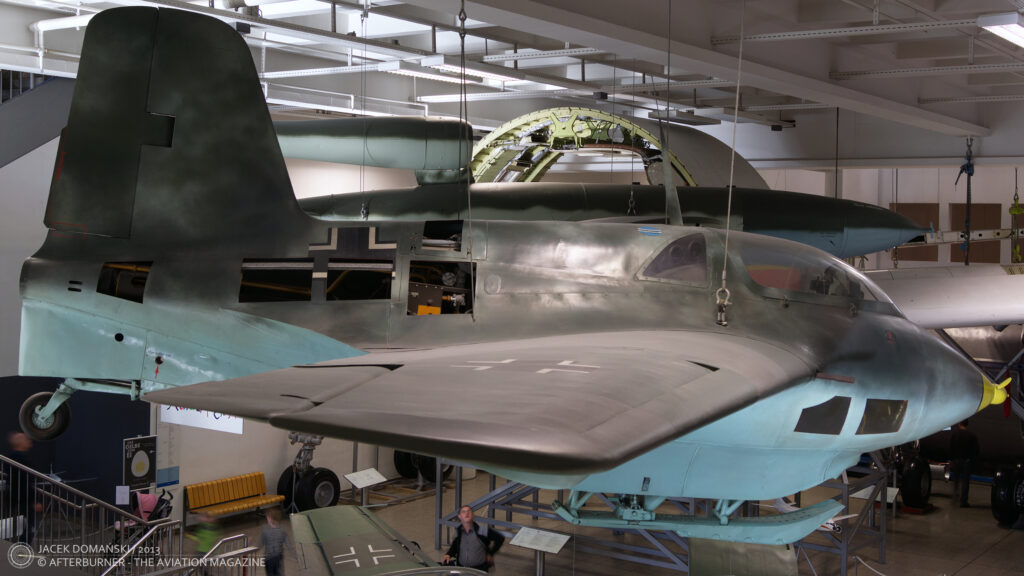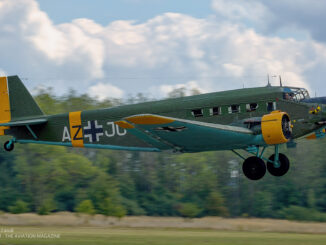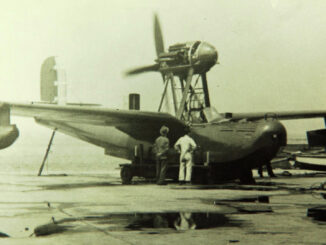 Messerschmitt Me 163B-1 Komet (c/n 191316?, formerly JG 400 of the Luftwaffe), exhibited in Deutsches Museum, Munich, October 2013.
Messerschmitt Me 163B-1 Komet (c/n 191316?, formerly JG 400 of the Luftwaffe), exhibited in Deutsches Museum, Munich, October 2013.
The Me 163 Komet is commonly associated with German anti-aircraft defence in the final years of the World War II, being one of desperate attempts of the Nazis to stop the Allied bomber offensive. Operationally introduced in 1944, the Me 163 was used in a role of point-defence interceptor with hope to stop the air raids on Germany.
Nevertheless, beginning of that interesting aircraft dates back to 1937 and the experiments carried out by German research institute for sailplane flight (Deutsche Forschungsanstalt für Segelflug – DFS). Apart from developing traditional gliders, the institute was working also on alternative power solutions for aeroplanes that included rocket engines, as well as experimental aircraft of delta wing configuration.
These works were supervised by Alexander Lippisch, the well-known German sailplane pioneer and designer. He was experimenting with the delta-wing aircraft already from the late 1920s and made a series of propeller-powered prototypes. The first of them, a tailless aircraft designated Lippisch Delta I, performed its maiden flight in 1930. It was soon followed by further studies that resulted in creation of Delta II – IV aeroplanes.
However, the development was not free from complications. After the initial successful flights of prototypes, the Delta series aircraft were involved in a few serious accidents and became the subject of investigation carried by German Aviation Research Institute (Deutsche Versuchsanstalt für Luftfahrt – DVL). As a conclusion, both the DVL and the Reich Air Ministry (Reichsluftfahrtministerium) found the delta-wing configuration as not prospective. Despite that, Lippisch´s development received support from Walter Georgii, the director of the DFS, and the works were continued.
As a part of the DFS-backed programme, Lippisch continued with development of his Delta IV design and used his previous studies to create another delta-wing aircraft, designated DFS 39. It finally broke the bad series and turned out to have good flying characteristics, thus was assessed by the German aviation authorities as promising design. Soon, the DFS 39 and its derivatives officially became the base to create rocket-powered aircraft.
In January of 1939, Lippisch and his team were transferred to Messerschmitt company. There, they began to work on ´Project X´, the official government programme to build a rocket-powered fighter. For that development, the prototype of DFS 194 experimental rocket-powered aircraft was used. The first prototype of the new fighter was completed in 1940 and then evaluated at Peenemünde test ground. On 1st September 1941, the Messerschmitt Me 163 – as the aircraft was officially designated – performed its maiden flight.
The German authorities were so impressed by the performance of the rocket-powered fighter that decision about launching its serial production was made within a few months. However, the design was very advanced and still faced several not finally solved issues. At that point, the Me 163 was still not optimized for mass production, so the Messerschmitt company almost immediately started to work on the Me 163B being both upgraded and simplified variant of the fighter.
In late 1942, the first experimental fighter unit flying the Komet was established. Nevertheless, the aircraft was officially introduced into operational service only in May of 1944. Although the Me 163 flying characteristics were exceeding any of the then known piston engine powered aircraft, the new German fighter suffered from many shortcomings – the engine was still unstable, resulting in complicated and dangerous pre-flight procedures, as well as short flight duration of only seven and a half minutes.
Finally, the operational use of the Me 163 was nothing than a big failure. There were approximately 370 examples of the aircraft built but they managed to shoot down only sixteen to eighteen Allied aircraft, depending on the source. Many of the Komets were not used in combat due to fuel shortage. And, last but not least, several fighter pilots died in accidents during the Me 163 training and test flights. For the Nazi Germany, the Project X was a complete waste of its resources.
The example exhibited in Deutsches Museum in Munich, was captured in 1945 and sent to the United Kingdom. It was then evaluated by the RAF and in April of 1964 donated to the Deutsches Museum.
However, as the aircraft several times changed its location within the RAF stations, as well as was presented to public during open days and similar events, there is a high possibility its true identity was lost. The same regarding the marking – for a certain time the Komet was exhibited as ´yellow 6´ but some reports indicate it should be ´60´, however of unknown colour. More research about the identity of the Me 163 being a part of Deutsches Museum exhibition is included in ´War Prizes´ book, by Phil Butler.



